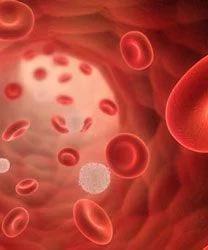Ropeginterferon-Treated Patients With Polycythemia Vera Significantly More Likely to Be Phlebotomy Free at 5 Years
December 22, 2020 - Patients with polycythemia vera who received ropeginterferon alfa-2b had a higher likelihood of being phlebotomy free in the fourth or fifth year of treatment vs those who received best available therapy.

Patients with polycythemia vera (PV) who received ropeginterferon alfa-2b (P1101) had a higher likelihood of being phlebotomy free in the fourth or fifth year of treatment vs those who received best available therapy (BAT), according to data from the CONTINUATION-PV study (NCT02218047), an extension of the phase 3 PROUD-PV trial (NCT01949805), which were presented during the 2020 ASH Annual Meeting & Exposition.
At 5 years, 55.8% of patients who received ropeginterferon experienced a complete hematologic response (CHR) compared with 44.0% of those who received the control (P = .0974). CHR was defined as a hematocrit level of less than 45% without phlebotomy for 3 or more months, a platelet level of less than 400 x 109/L, and a white blood cell count less than 10 x 109/L.
The rates of CHR with last observation carried forward at year 5 and were 72.6% in the ropeginterferon arm vs 52.6% of those in the control arm, representing a significant difference (P = .004), according to Heinz Gisslinger, MD, director for Clinical and Translational Research in Myeloproliferative Neoplasms and Multiple Myeloma at the Medical University of Vienna, Austria, who shared the data in a presentation during the meeting.
Moreover, in the fifth year of treatment, 81.8% of ropeginterferon-treated patients had maintained hematocrit levels of less than 45% without the need for phlebotomy vs 63.2% of those in the control arm (P = .01).
CONTINUATION-PV is an open-label, multicenter, phase 3b extension of PROUD-PV in which the long-term safety and efficacy of ropeginterferon alfa-2b was compared with BAT in patients with early PV. PROUD-PV enrolled a total of 254 patients who were either cytoreduction naïve or pretreated with hydroxyurea for less than 3 years. These patients were randomized to receive either ropeginterferon or hydroxyurea at individualized doses for 12 months. In the extension study, patients in the hydroxyurea arm were permitted to switch to BAT.
A total of 171 patients, 95 in the ropeginterferon arm and 76 in the control arm, entered the extension phase. In the first and second years of treatment, the median cumulative dosage of ropeginterferon per 4-week period was approximately 750 µg, which was reduced to a median of 499 µg in years 3 through 5.
Of the patients who failed to meet the definition of CHR at month 60, 28.6% of the 42 in the ropeginterferon arm and 21.4% of the 42 in the hydroxyurea arm failed to achieve the hematocrit end point. Premature discontinuation followed by elevated hematocrit was the reason in 59.5% of patients in the investigative arm and 40.5% of those in the control arm. However, 68% of those who discontinued treatment prematurely in the ropeginterferon had already achieved a CHR compared with 35% of those in the control arm.
Additional results showed a pronounced difference in the molecular response (JAK2V617F burden) between the 2 treatment arms, with “striking superiority of ropeginterferon at month 60,” Gisslinger noted.
Specifically, the median JAK2V617F allele burden at year 5 was 8.5 in the ropeginterferon arm vs 44.4 in the control arm (P < .0001). Additionally, the percentage of patients with a JAK2V617F burden of less than 10% was 53% vs 12% in the investigative and control arms, respectively (P <.0001).
Approximately 69% of patients assigned to ropeginterferon vs 21.6% of those assigned to the control experienced a molecular response at 5 years according to ELN criteria (P <.0001).
A combined analysis of hematocrit of less than 45% without phlebotomy and molecular response showed that 58.5% of patients in the ropeginterferon arm vs 17.3% of those in the control arm achieved this end point (P <.0001).
“Disease progression was rare during long-term treatment, which might reflect a change in the natural history of PV due to deep and durable molecular responses with ropeginterferon treatment,” Gisslinger added.
The incidence of thromboembolic events was 1.2% in both arms. During the 5-year period, 1 case of progression to myelofibrosis was reported among patients assigned to ropeginterferon and 2 cases among those who received the control. No cases of leukemic transformation were noted among those assigned to the ropeginterferon arm compared with 2 of those assigned to the control arm.
No new safety signals emerged in the fifth year of treatment, “confirming the good tolerability of this novel pegylated interferon in the long term,” concluded Gisslinger.
Reference
- Gisslinger H, Klade C, Georgiev P, et al. Long-term use of ropeginterferon alpha-2b in polycythemia vera: 5-year results from a randomized controlled study and its extension. Presented at: 2020 ASH Annual Meeting & Exposition; December 5-9, 2020; Virtual. Abstract 481. http://bit.ly/3azYbWl.



